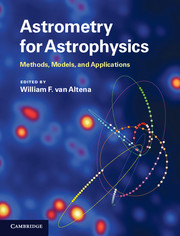Book contents
- Frontmatter
- Contents
- List of contributors
- List of acronyms
- Preface
- Part I Astrometry in the twenty-first century
- Part II Foundations of astrometry and celestial mechanics
- Part III Observing through the atmosphere
- 9 The Earth's atmosphere: refraction, turbulence, delays, and limitations to astrometric precision
- 10 Astrometry with ground-based diffraction-limited imaging
- 11 Optical interferometry
- 12 Radio astrometry
- Part IV From detected photons to the celestial sphere
- Part V Applications of astrometry to topics in astrophysics
- Index
- References
10 - Astrometry with ground-based diffraction-limited imaging
from Part III - Observing through the atmosphere
Published online by Cambridge University Press: 05 December 2012
- Frontmatter
- Contents
- List of contributors
- List of acronyms
- Preface
- Part I Astrometry in the twenty-first century
- Part II Foundations of astrometry and celestial mechanics
- Part III Observing through the atmosphere
- 9 The Earth's atmosphere: refraction, turbulence, delays, and limitations to astrometric precision
- 10 Astrometry with ground-based diffraction-limited imaging
- 11 Optical interferometry
- 12 Radio astrometry
- Part IV From detected photons to the celestial sphere
- Part V Applications of astrometry to topics in astrophysics
- Index
- References
Summary
Introduction
The construction of large ground-based optical and infrared telescopes is driven by the desire to obtain astronomical measurements of both higher sensitivity and higher angular resolution. With each increase in telescope diameter the former goal, that of increased sensitivity, has been achieved. In contrast, the angular resolution of large telescopes (D > 1m), using traditional imaging, is limited not by the diffraction limit (θ ∼ λ/D), but rather by turbulence in the atmosphere. This is typically 1″, a factor of 10–20 times worse than the theoretical limit of a 4-meter telescope at near-infrared wavelengths. This angular resolution handicap has led to both space-based and ground-based solutions. With the launching of the Hubble Space Telescope (HST), a 2.4-m telescope equipped with both optical and infrared detectors, the astronomical community has obtained diffraction-limited images. These optical images, which have an angular resolution of ˜0.″1, have led to exciting new discoveries, such as the detection of a black hole in M87 (Ford et al. 1994) and protostellar disks around young stars in Orion (O'Dell et al. 1993, O'Dell and Wen 1994). However, HST has a modest-sized mirror diameter compared to the 8–10 meter mirror diameters of the largest ground-based telescope facilities.
With the development of techniques to overcome the wavefront distortions introduced by the Earth's atmosphere, diffraction-limited observations from the ground have become possible. These techniques cover a wide range of complexity and hence expense. Speckle imaging, which provided the earliest and simplest approach, is described in Sections 10.1 and 23.3.1 and adaptive optics, which has more recently become scientifically productive and which is a much more powerful technique, is discussed in Section 10.2.
- Type
- Chapter
- Information
- Astrometry for AstrophysicsMethods, Models, and Applications, pp. 142 - 153Publisher: Cambridge University PressPrint publication year: 2012



